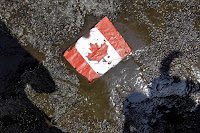There are three main projects under consideration right now that would bring millions of gallons of tar sands oil out of Canada every day. Kinder Morgan wants to expand its Trans Mountain pipeline to the west, where oil could be shipped south to California’s refineries. Enbridge is trying to increase capacity in two pipelines in Minnesota which would feed into a system carrying oil down to the Gulf Coast. And TransCanada is proposing a major pipeline to the maritime provinces in order to ship tar sands oil down the Eastern Seaboard.
Oil from tar sands is incredibly heavy oil — it is very thick, tar-like. Technically known as bitumen, the petroleum product has to be diluted in order to flow through pipelines. Alberta has one of the largest bitumen deposits in the world. In fact, the Alberta tar sands produce more oil each year than the entire country uses. For this reason, and because some 90 percent of the facilities for refining the heavy oil are located in the Gulf Coast, the United States is the biggest buyer of tar sands oil.
And tar sands oil, from a climate and environmental safety perspective, is really bad.
According to the Union of Concerned Scientists, a gallon of gasoline from bitumen is responsible for 15 percent more carbon dioxide emissions than a gallon of gas from conventional oil. In addition, the energy-intensive tar sands oil extraction process uses a lot of water, which ends up in toxic man-made pools.
Bitumen also poses a greater risk to the environment if (or when) it spills. While convention oil is certainly difficult to clean up (see: Exxon Valdez; Deepwater Horizon), bitumen is even harder to put back in the bottle. Bitumen sinks. When an Enbridge line ruptured in the Kalamazoo River six years ago, the company had to dredge the river in order to get the heavy oil out. They had only moderate success, while devastating the river's ecosystem.
It's partly for this reason that the Natural Resources Defense Council (NRDC) recommended in a report this week that the United States consider a ban on bitumen transportation in U.S. waters.
Read more at They Killed Keystone. Now What?

No comments:
Post a Comment